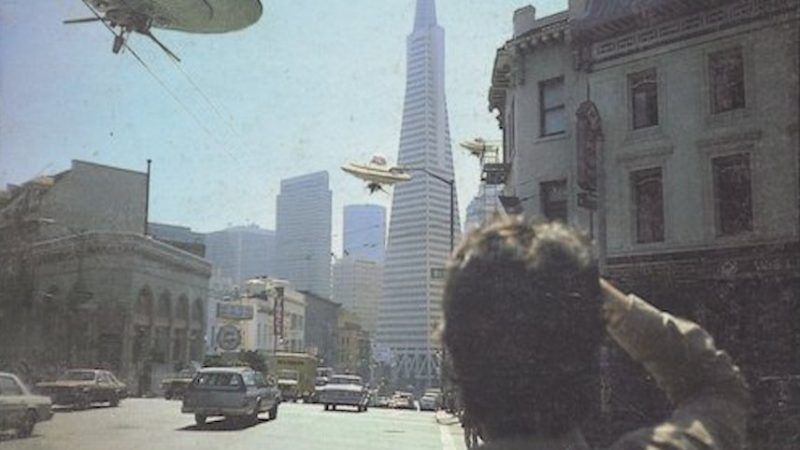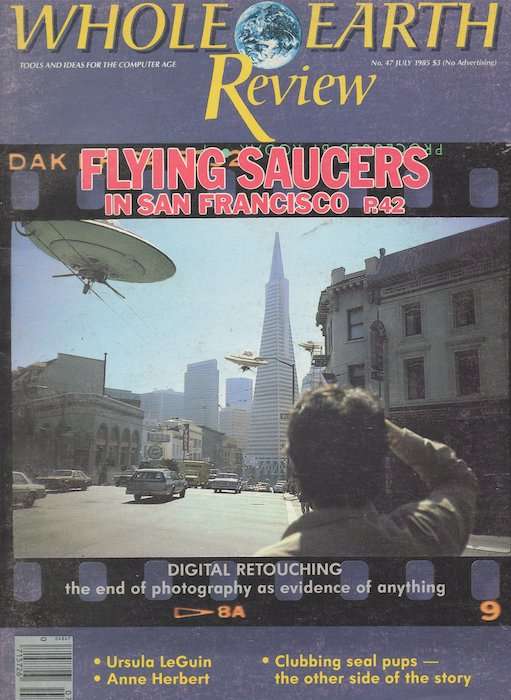Before People Fretted About Fake Videos, People Fretted About Fake Photographs
Do deepfakes really represent "the collapse of reality"?

Franklin Foer has heard about deepfake videos, and he's worried. His latest chin-stroker in The Atlantic, headlined "The Era of Fake Video Begins," warns that in a world of "almost seamlessly stitched" visual fakery, our eyes will "routinely deceive us." Video manipulations "will create new and understandable suspicions about everything we watch," and figures in the news "will exploit those doubts." Our "strongest remaining tether to the idea of common reality" will fray, and "the collapse of reality" will follow.
The whole thing gave me deja vu, because I'm old enough to remember when this magazine came out in 1985:

Come for the faked photo of saucers over San Francisco; stay for the story headlined "Digital Retouching: The End of Photography as Evidence of Anything."
Comparing Foer's feature to that old Whole Earth Review is a little unfair, because the Whole Earth article is actually rather good. It's not an essay but a roundtable discussion, with Stewart Brand, Kevin Kelly, and Jay Kinney weighing in on what would happen now that the old laborious photo-doctoring processes were giving way to far faster and easier digital manipulations; between them, the trio has the historical and technological perspective that Foer's story lacks. But like practiced showmen, they open with an attention-grabbing scary scenario:
"Your honor, we cannot accept this photograph in evidence. While it purports to show my client in a motel bedroom with a woman not his wife, there is no way to prove the photograph is real. As we know, the craft of digital retouching has advanced to the point where a 'photograph' can represent anything whatever. It could show my client in bed with your honor.
"To be sure, digital retouching is still a somewhat expensive process. A black-and-white photo like this, and the negative it's made from, might cost a few thousand dollars to concoct as fiction, but considering my client's social position and the financial stakes of this case, the cost of the technique is irrelevant here. If your honor prefers, the defense will state that this photograph is a fake, but that is not necessary. The photograph COULD be a fake; no one can prove it isn't; therefore it cannot be admitted as evidence.
"Photography has no place in this or any other courtoon. For that matter, neither does film, videotape, or audiotape, in case the plaintiff plans to introduce in evidence other media susceptible to digital retouching." —Some lawyer, any day now.
Two things about that monologue jump out. The first is that it sounds a lot like Foer's fears about video manipulations today. The second is that photographs are in fact still used as evidence in courtrooms, with generally agreed-upon standards for when to treat them as authentic. The reasons why they still get used as evidence in 2018 were explained in advance by Kevin Kelly in that same Whole Earth forum:
We've been spoiled by a hundred years of reliable photography as a place to put faith, but that century was an anomaly. Before then, and after now, we have to trust in other ways. What the magazines who routinely use these creative retouching machines say is "Trust us." That's correct. You can't trust the medium; you can only trust the source, the people. It's the same with text, after all. You can print a lie in 100,000 subscriptions and it looks the same in ink as the truth. The only way to tell is by the source being trustworthy. The only way my words are evidence is if I don't lie, even though it's so, so easy to do.
We know what it looks like when a crisis of trust hits the courts, because we've seen it happen in several cities. Thousands of people have been released from jail because particular cops or crime-lab employees turned out not to be trustworthy. Those convictions were not overturned because Americans lost their faith in photographs, or in any other technology. They were overturned because institutions themselves, or members of those institutions, lost public faith.
When people trust institutions, they generally trust the evidence those institutions present. When people do not trust institutions, they find reasons to reject evidence or just to read it differently. It's telling that Foer calls the passing age of trustworthy motion pictures "Abraham Zapruder's world," invoking the amateur cameraman who captured John F. Kennedy's assassination. If you were to select a single example that best demonstrates how even an unaltered, undoctored film can attract a storm of competing interpretations, surely the prime candidate would be Zapruder's much-debated 486 frames of footage. If this is your "tether to the idea of common reality," you need a new rope.
Foer isn't oblivious to the underlying problem, but he approaches it in a backward way:
Few individuals will have the time or perhaps the capacity to sort elaborate fabulation from truth. Our best hope may be outsourcing the problem, restoring cultural authority to trusted validators with training and knowledge: newspapers, universities. Perhaps big technology companies will understand this crisis and assume this role, too. Since they control the most-important access points to news and information, they could most easily squash manipulated videos, for instance. But to play this role, they would have to accept certain responsibilities that they have so far largely resisted.
Having mistaken a crisis of trust in institutions for a crisis of technology, Foer suggests we solve the tech crisis by restoring trust in institutions. Good luck with that.
My expectations are less apocalyptic than Foer's. I don't think video evidence will disappear any more than photographic evidence did three decades ago, but there will be more noise around that evidence. We will figure out ways to navigate through the noise, and those ways will be imperfect, but if we're lucky we'll be clear-eyed about those imperfections. The best we can hope for is an ecosystem of mutual peer review where everyone is fallible and no one is the final authority.
A broad social shift is underway in societies around the world—a point at which modernity starts eroding not just traditional authority but the authorities erected by modernity itself. People like Foer respond to that by longing for the old certainties and the institutional power that protected them, but I doubt it's possible to restore that social order and I certainly wouldn't want to. This has always been a world of rumors, disinformation, and fog. There aren't necessarily more deceptions today than in the past; it's just more dizzyingly obvious that we live in a wilderness of mirrors. As those old illusions collapse, Foer thinks he's watching the collapse of reality.


Show Comments (45)